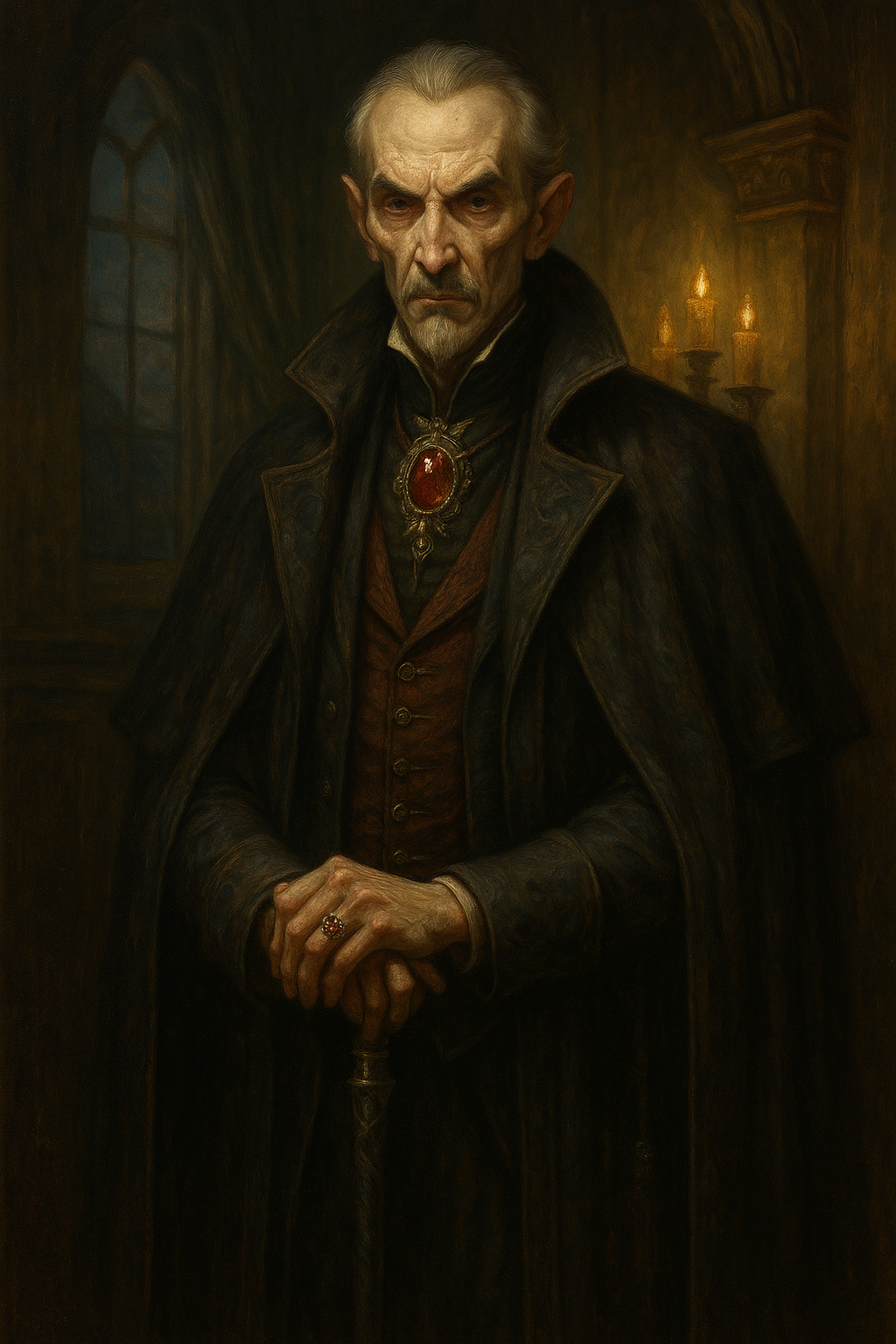The Count of Thorneblight: A Smile Sharper Than Steel
“By Trickin’s cursed coin purse... I’ve met liches with more honesty in their eye sockets.”
Lads, lemme tell ya — I’ve seen tyrants. Real ones. Skull-crowned necromancers, warlords with blood-soaked blades, sorcerers with thunder for tongues. But none o’ them chilled me the way Count Thorneblight did.
See, this ain’t a man who rules. This is a man who hosts. He throws galas while he audits your soul. Serves wine while his spies rifle your thoughts. He’ll compliment yer cloak while noting the best vein to drain.
His town smiles because it’s scared to blink. His guards bow lower than their knees were built for. And under that mansion of his? Somethin’ breathes.
If yer party ever gets an invite to dinner? Skip it. Or show up dressed for a funeral — preferably yer own.
📌 Wanna understand what keeps this monster warm at night? Pay a visit to The Pale Widow — but mind the thorns.
Who (or What) Is Thorneblight?
Count Elgar Thorneblight — though he’ll insist on Grand Viceregent of the Western Vale — is part courtier, part parasite. He came from the capital with silver rings, impeccable grooming, and the kind of charm that glides. Within two months, the mayor had “retired,” the guard captain was “transferred,” and the village charter had six new pages written in invisible ink.
Appearance:
Pale, powdered skin — but no scent of rot. His undead? Elegant.
Long coats with alchemical stitching. The colors shift subtly: red near rebels, black near beasts, white at funerals.
A voice like soft leather creaking under daggerweight.
Mannerisms:
Always smiling. Never blinking. Often asking questions that seem polite... until you realize they trap answers.
Writes constantly. Carries a 3-quill ledger. It hums when he’s angry.
His Power Is Administrative, Arcane, and Abominable
Thorneblight doesn’t just use soldiers or spells. He uses systems. He rewrites the law. Redesigns social rituals. Wields guilt like a longsword.
Magic School Focus: Enchantment (for manipulation), Abjuration (for rules), and traces of Necromancy (but make it subtle).
Combat? Rare. He redirects combat — wards, clones, decoys, or worse: emotional bargains that hurt more than blades.
He signs letters in blood… but they’re never his.
Influence Map
Here’s what Thorneblight commands — whether directly or via smiling proxies:
🎭 The Pale Widow – His consort, priestess, or power behind the throne.
🏘️ Thorneblight Village – The “peaceful” town under his “care.”
🏰 The Briarbone Manor – His home. Every door a test. Every mirror a lie.
🛡️ Captain Nail – His loyal enforcer, stitched together and lawful to a fault.
🧪 Minions of the Count – Alchemist, beastmaster, and whispering interrogator.
🐀 The Undercrawl – The sewers beneath the manor. The Count does not go there himself.
🌲 Ravennest Wilds – The edge of his reach. And the last place you’ll feel truly free.
🐍 Spies in the Wine Cellar – Not all enemies wear fangs. Some wear aprons.
Count Elgar Thorneblight - Stat Block
Medium humanoid (variant human, possibly undead or fey), Lawful Evil
CR 12 | XP 8,400
Armor Class: 18 (Tailored Warding Attire)
Hit Points: 184 (24d8 + 72)
Speed: 30 ft.
STR 10 (+0)
DEX 16 (+3)
CON 16 (+3)
INT 20 (+5)
WIS 14 (+2)
CHA 22 (+6)
Saving Throws: Int +10, Wis +7, Cha +11
Skills: Insight +7, Persuasion +11, Deception +11, Arcana +10, History +10
Damage Resistances: psychic, necrotic; bludgeoning/piercing/slashing from nonmagical weapons (if undead version)
Condition Immunities: charmed, frightened
Senses: passive Perception 12, darkvision 60 ft.
Languages: Common, Elvish, Infernal, Deep Speech
Abilities
Silver Tongue of Thorneblight (Recharge 5–6)
As a bonus action, the Count can force one creature within 60 feet who can hear him to make a DC 18 Wisdom saving throw. On a failure, the target is charmed for 1 minute, believing the Count is a trusted ally. While charmed, the target has disadvantage on Insight checks against the Count and treats him as non-hostile, even during combat. This effect ends early if the Count harms the target.
“Let us speak plainly, friend. I think we both want what’s best for the village…”
Signature Ledger (1/Day)
As an action, the Count inscribes a creature’s name into his black ledger (visible only to him). That creature must succeed a DC 18 Charisma saving throw or be cursed for 24 hours.
While cursed:
The creature has disadvantage on all saving throws against enchantment spells.
Once per round, the Count may impose disadvantage on any attack or saving throw it makes (no action).
False Courtesy (Legendary Resistance, 3/Day)
When the Count fails a saving throw, he may choose to succeed instead — by giving the GM a chilling verbal line to speak aloud (something like “Ah, but I had already accounted for that, dear.”)
Spellcasting
The Count is a 13th-level spellcaster. His spellcasting ability is Charisma (spell save DC 18, +10 to hit with spell attacks).
He knows the following spells:
Cantrips (at will):
Prestidigitation, Mage Hand, Minor Illusion, Vicious Mockery
1st level (4 slots):
Charm Person, Command, Shield, Detect Magic
2nd level (3 slots):
Suggestion, Mirror Image, Hold Person
3rd level (3 slots):
Counterspell, Hypnotic Pattern, Dispel Magic
4th level (3 slots):
Greater Invisibility, Phantasmal Killer
5th level (2 slots):
Dominate Person, Modify Memory
6th level (1 slot):
Mass Suggestion
7th level (1 slot):
Forcecage
Legendary Actions (3/round)
The Count can take 3 legendary actions, choosing from the options below. Only one legendary action can be used at a time and only at the end of another creature’s turn.
Command the Room. One creature of the Count’s choice within 30 feet must make a DC 18 Wisdom saving throw or immediately move 15 feet in a direction the Count chooses.
Mask of Grace. The Count teleports up to 10 feet and becomes heavily obscured by swirling illusions until the start of his next turn.
Ledger Strike (Costs 2). The Count calls upon a false entry in his ledger. One cursed target takes 6d6 psychic damage (no save) as they see a false memory of their own betrayal.
Lair Traits (If in Briarbone Manor)
While inside his estate, the Count can:
Cast Suggestion or Command once per round as a lair action, no slots required.
His servants (including constructs or animated furniture) have advantage on all saves while within the manor.
Any charm effect from the Count has +2 to its DC.
GM Notes & Usage
The Count is not a raw combat challenge — he’s a control-and-collapse boss.
He’s dangerous when surrounded by civilians, minions, or law — think social boss fight.
Ideal finale: party invades the manor, breaks enchantments, and exposes him before the public — or takes him out with force and loses the town’s trust.
GM Tips: Using the Count in Your Campaign
He’s a slow burn. Introduce him early via letters, laws, and rumors. Let players realize too late that every small convenience came from him.
Use dinner scenes. He never fights unless cornered. Instead, he invites. Confesses. Gaslights. Offers deals too tempting to refuse.
His downfall isn’t brute force — it’s exposure. Players must pull masks, not just swords.
📌 Like yer villains with velvet voices and venomous ledgers?
👉 The Count’s not just evil — he’s organized. Drop him in your next arc, but be warned: once he smiles at the party… yer game’s gonna bleed slow.
FAQ
Q: Is the Count undead, fey, or human?
A: Depends on the campaign. He’s built modular — act like he’s human, sprinkle undead hints, and let the party uncover what’s real… or what’s been replaced.
Q: Can he be killed early?
A: Only if yer party wants a worse villain to rise. Have a contingency. The Count always does.
Q: What if my players side with him?
A: Then yer table’s got taste. Let ‘em. He rewards loyalty. Just… not forever.
📌 By Elgrin’s empty scrollcase, if yer players think charm is harmless, let the Count teach ‘em why the devil always knocks politely.
👉 Bring yer villains to life, weave their worlds, and build a campaign the fools’ll never forget at Mike’s Tavern Toolshed or contact the barkeep before yer plot folds like a cheap tent.

